Bengal cat progression and growth are fairly similar to many other cats. There are many things about them, however, that are entirely unique to the breed!
Due to their striking, leopard-like appearance, Bengal cats have become one of the most popular cat breeds in the world. The variety of colors draws people who are looking for the perfect exotic-looking pet for their family. While they look like wild cats, Bengals have personalities similar to common house cats. Generally, they do not like to be picked up or held, but they will happily snuggle on the couch.
Since they are so popular, we want to give you a detailed overview of these cats. We will cover general information, growth, health concerns, and tips to help your Bengal live a long, happy life. Let’s jump right in and learn all about Bengal cat progression, growth, and more!
Brief Bengal Cat Summary

Bengal cats were created to have a wild look and a sweet personality.
©Lopolo/Shutterstock.com
History
The Bengal breed began with a scientific experiment in 1971 disguised as a special project between father and children. Dr. Willard Centerwall brought the idea to his children as a question and offered to allow them to help with the project. He asked if they would rather have a spotted cat or a striped dog. They chose the cat and the project began! He didn’t tell them that he had hoped they would pick the cat all along because he secretly wanted to create a domestic cat with immunity to Feline Leukemia Virus (FeLV).
Unfortunately, crossing the FeLV-immune Asian leopard cat to domestic cats did not produce kittens with the same immunity. What it did create was beautiful spotted kittens that would later become the ancestors of the Bengal breed we know today. Dr. Centerwall worked with Jean Mill to further the breed and bring in the personalities they wanted. Mill had actually been the first to make the cross in 1963 but had abandoned the project until teaming up with Dr. Centerwall in the 1980s.
The first-generation crosses (F1) were often mean or skittish and did not make good pets. When Dr. Centerwall retired, he gave many of his cats to Mill. She then worked tirelessly under the cattery name “Millwood” to breed nice, friendly cats that people would love. She was very successful! Some Bengal cats alive today still have the Millwood name on their pedigrees (or family trees).
Current Times
The progression of Bengal cats from small, skittish wild-acting creatures to the loveable lap leopards we know today is astonishing! Now, there are more than 250,000 Bengals across the world. They are eligible for Championship titles obtained in cat shows hosted by cat registries. The International Cat Association (TICA) and the Governing Council of the Cat Fancy (GCCF) are two registries that register Bengals. They also keep track of pedigrees and breedings. Breeders on nearly every continent create beautiful, loving Bengal kittens to adopt out to loving homes.
Bengal Cat Growth and Weight Chart by Age
Bengal cat progression is generally a quick process, at least at the beginning. Kittens double in size roughly every two weeks until they reach about two months old. After this, they should be gaining about one pound per month until around six months old, then growing begins to slow down. Some Bengals have reached their adult size by this time but will continue to mature. These cats have very muscular bodies that take time to fill out. Males who are left intact (not neutered) will grow thick jaw muscles called jowls. That’s because they need strong jaws and muscles to fight for courtship with females. In the wild, only the strongest Asian leopard cat males get to breed.
| Age | Average Weight |
|---|---|
| Newborn | 3-5 ounces |
| 2 weeks | 6-10 ounces |
| 4 weeks | 12-20 ounces (0.75-1.25 pounds) |
| 6 weeks | 1.5-2.5 pounds |
| 8 weeks (2 months) | 3-3.5 pounds |
| 3-4 months | 4-6 pounds |
| 5-6 months | 6-12 pounds |
| 7-10 months | 8-15 pounds |
| 12 months (1 year) | 8-18 pounds |
| 2 years | 8-20 pounds |
When Will My Bengal Cat Stop Growing?
Bengals stop being kittens at about a year old but continue growing until about two years old. They will likely reach their adult size (height and length) within one year of birth, but they will continue to gain muscle and weight for up to another year.
How Big Will My Bengal Cat Be When It’s Fully Grown?
Bengal cats are considered a large cat breed. They typically weigh 8-20 pounds when fully grown. This greatly depends on gender, pedigree, and distance from the Asian leopard cat ancestors. Generally, males grow larger than females. Early-generation (EG) Bengals tend to be smaller than their later-generation cousins. The Bengal cat’s lifespan ranges from 12-20 years, so kittenhood is just a short part of their life.
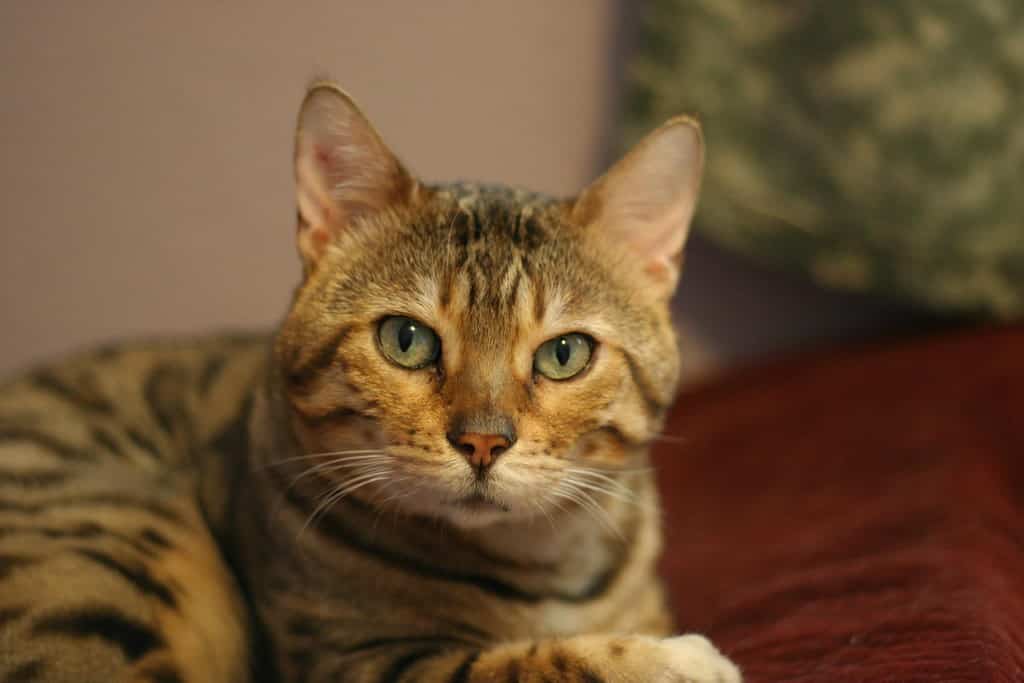
When Should My Bengal Stop Eating Kitten Food?
Bengal kittens, like all kittens, need to eat kitten food for at least the first year of life. This is because kitten food contains extra vitamins, minerals, and fat content that kittens need to grow properly. Once your Bengal kitten reaches its first birthday, you can begin slowly transitioning them to high-quality adult cat food over about 1-2 weeks. This will help prevent any stomach upset when changing to the new food.
When Will My Cat Start Losing Teeth?
Kittens start losing their teeth as early as four months old. Your Bengal cat should have all of its adult teeth by the time it is a year old. It is a good idea to have your veterinarian check your kitten’s teeth every time they go in for a visit. This will help make sure they do not have persistent deciduous teeth.
When Should I Start Training My Bengal Cat?
Some people might not think cats can be trained, but Bengal cats are very smart creatures. You can start training as soon as you bring them home from the breeder. That’s usually between 12-16 weeks old. The rate of your Bengal cat’s progression in training is up to you and your cat!
What Commands Should I Teach Bengal Cat First?
Teaching a Bengal cat to do tricks might seem like a difficult task, but you can start simple. Make sure to pick short, 1-2 word commands so your cat doesn’t get confused. It will help if you can break treats into very small pieces so they don’t spend too much time eating and are quickly ready for another. Let’s learn a couple of commands you can start out teaching your Bengal cat.

Come When Called
Using their favorite treat, call your kitty to you. When they come, they get a treat. Make sure to give them a treat as soon as they are close enough to do so. As your Bengal gets better at this, you can ask them to get closer and closer before they get their treat.
You can also teach them to come to certain places! Tap the place you want your Bengal to go and give the command. As soon as they reach the spot, give them the treat. It’s that easy!
Crate/Carrier
Another great command to teach your cat early is going into their crate or carrier. You can do this easily by calling them over and giving them a treat as soon as they get close to the carrier. Once they learn the word, it gets even easier. When your kitten is readily going near the crate when you say your word, start putting the treat inside it. They will go in after it, and you can praise them with your voice and pets.
Up/Stand Up
A fun command to teach is “up.” You can teach this by holding a treat above your Bengal’s nose and saying “up.” As soon as their front feet leave the floor, give the treat. You can slowly move the treat higher and higher until they stand up on their back feet to get it!
Training Tips
Don’t be frustrated if your Bengal doesn’t seem to be responding to treats. You can use a fun toy instead. Cats sometimes take more convincing, but once they start getting the hang of it, you can teach them all kinds of tricks. The Amazing Acro-Cats are a group of cats that have been trained to put on a circus-like show for cat lovers all over the United States!
When Should My Bengal Cat Be Potty Trained?
Bengal cat progression is largely instinctual. Instinct is a cat or other animal’s natural urge to do something. Cats have the instinct to cover their waste. This comes from their wild ancestors that needed to hide the evidence of their living area from predators.
If your Bengal kitten comes from a breeder, it should already be potty trained to use the litter box. Kittens begin exploring the litter box and learning to use it as early as 3-4 weeks old. Their mother helps reinforce this habit between the 8-16 weeks. You should not adopt a kitten that is less than 12 weeks old unless it absolutely cannot be with its mother anymore. For instance, if the mother passed away. They learn so much from their mothers during this time, and removing them early can cause behavior problems. These issues can be sucking on blankets, separation anxiety, and peeing outside the litter box.
What To Do If Your Bengal Not Using the Litter Box
If your Bengal cat is not using the litter box after the age of 12 weeks, take them to see your veterinarian. A cat that hasn’t been spayed/neutered yet can start spraying (the term for scent marking their territory with urine) as early as four months old. However, you should not assume this is what is happening without talking to your veterinarian. Bengals are prone to urinary problems, and ruling those out is very important to your cat’s health. If there is no medical reason found, it might be a behavioral problem.
If your litter box problems are behavioral, there are things you can do to help:
- More litter boxes. As a general rule, there should be one litter box per cat plus one. Two boxes next to each other count as one! Spread them out.
- Keep the box clean. Scoop your litter box at least once daily. If that does not work, scoop it more often. Still a problem? Consider an automatic litter box that scoops each time it is used.
- Change the litter type. Some Bengals are sensitive to litter that has too much scent in it. Try an unscented litter or switch to a plant-based litter such as pine pellets.
- Change the type of litter box. Some cats don’t like a lid on their litter box. Some prefer it. Try different ones until you find one they like. A Bengal might need an extra large litter box!
When Should My Bengal Cat Be Spayed or Neutered?
Bengal cats can be safely spayed or neutered as early as eight weeks old and two pounds (though weighing 3-4 pounds is preferred). Many veterinarians recommend waiting until the cat reaches six months before they perform this surgery. Some breeders have kittens spayed or neutered before they are adopted or place strict rules in the adoption contract regarding when this should be done. That means this decision will have to be made between you, your breeder, and your veterinarian based on rules, preferences, and medical opinion.
It is highly recommended to make sure your Bengal female is spayed. That’s because they can get a life-threatening condition called pyometra. This disease causes a build-up of infection inside the uterus (where kittens grow when the mother is pregnant). If the uterus breaks open inside her, the infection can take over the entire body and lead to death.
When Will My Bengal Start to Calm Down?
If you’re looking for a calm, lazy house cat, a Bengal might not be the right breed for you. These cats are known for their high energy and amazing athletic antics. Most Bengals keep up their energetic ways well into their teen years, though you can expect them to get into less trouble as they mature.
Is your Bengal becoming destructive or keeping you up at night with zoomies? You should consider spending more time playing with them. You can entertain them with interactive toys such as a laser light they can chase. Bengals will almost always enjoy a good play session but should begin to calm down around 4-5 years old.
Common Health Issues Seen In Bengal Cats
Bengal cat progression also depends on any problems that are present. This can be anything from lack of proper nutrition, lack of exercise, or health concerns. Several health conditions are common in Bengal cats. That’s why it’s important to carefully research the breed and find a responsible breeder.
If you become concerned about your Bengal cat, take it to your veterinarian for an exam!
Heart Concerns
Bengals are prone to a genetic heart condition passed from parent to kitten. Hypertrophic cardiomyopathy (HCM) is a disease that causes the walls of the heart to thicken over time. This leads to poor circulation of blood and eventually death. The condition is often a silent and sudden killer. It can strike even before they reach one year old by way of a blood clot. This type of blood clot is called aortic thromboembolism or ATE. When choosing a breeder, be sure to ask if they test their breeding cats for this condition. Testing requires a visit to a veterinary cardiologist (or heart doctor for pets).
Eye Concerns
PRA-B, or Progressive Retinal Atrophy-Bengal, is another condition passed from parent to kitten. This one affects the eyes by causing degeneration (or breaking down) of the retina inside the eye. The retina is responsible for transforming images into electrical signals that get sent to the brain to be read. If the retina doesn’t work, the cat cannot see. The test for this condition is a simple mouth swab breeders send to a laboratory. Breeders should test every cat they breed to keep this disease from continuing in the breed. However, there is more than one type of PRA, and testing does not guarantee the cat will never develop the condition. PRA is common in many breeds of cats and dogs.
Urinary Concerns
Bengal cats are at risk of developing crystalluria (or crystal formation in the urine). This can lead to a urinary blockage (inability to pee) which is an absolute emergency! Male cats are at a higher risk for blockage. If the blockage cannot be removed by a veterinarian, the cat will die. Unfortunately, even Bengals without crystalluria can develop a urinary blockage. This condition is caused by Feline Idiopathic Cystitis (FIC). Idiopathic means there is no identifiable medical cause for a problem. Cystitis refers to inflammation of the bladder and urinary tract. Both crystalluria and FIC can be treated with special veterinary diets designed to break up crystals and reduce stress.
Other Concerns
Pyruvate kinase deficiency (PK def) is yet another genetic condition in Bengal cats. This disease causes the body to destroy red blood cells before more can be made, leading to anemia (the lack of red blood cells). The only treatments for this condition are blood or bone marrow transfusions. These treatments rarely go well in cats and are not a cure. They are also extremely expensive. PK def can also be tested for by mouth swab, but a cat who is clear will not develop or pass on the disease. There is no excuse for a breeder not to test for this condition. If a breeder cannot give you health testing records, do not adopt from them!
Pictures of Bengal Kittens Newborn to 6 Months
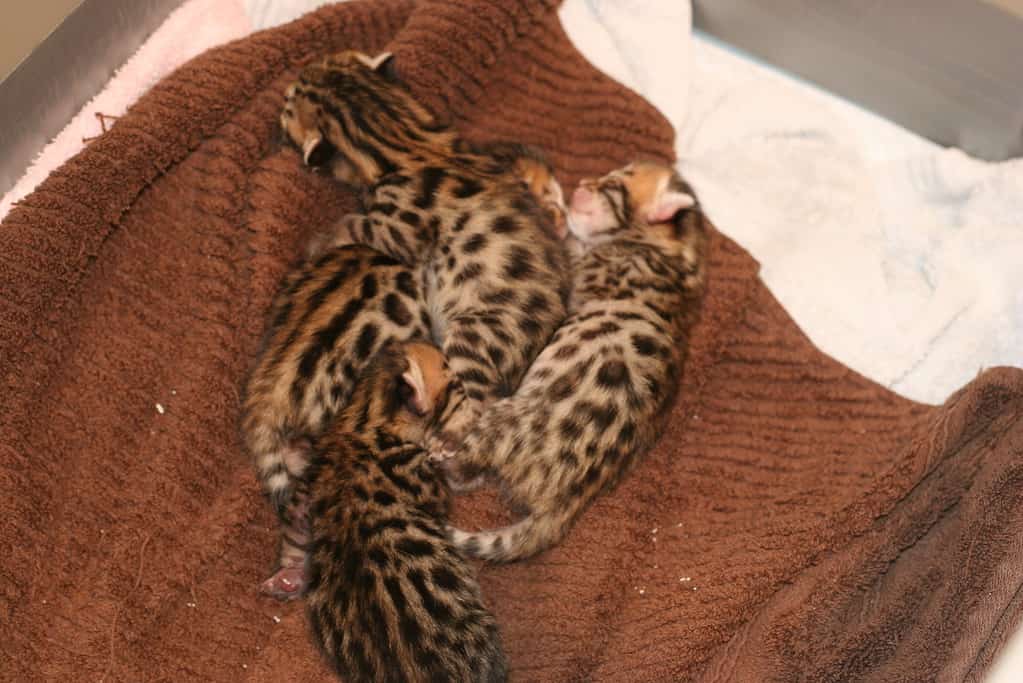

Weighing only 6-10 ounces at two weeks old, Bengal kittens rely heavily on their mother.
©A-Z-Animals.com/Rachael Monson / Nemera Bengals
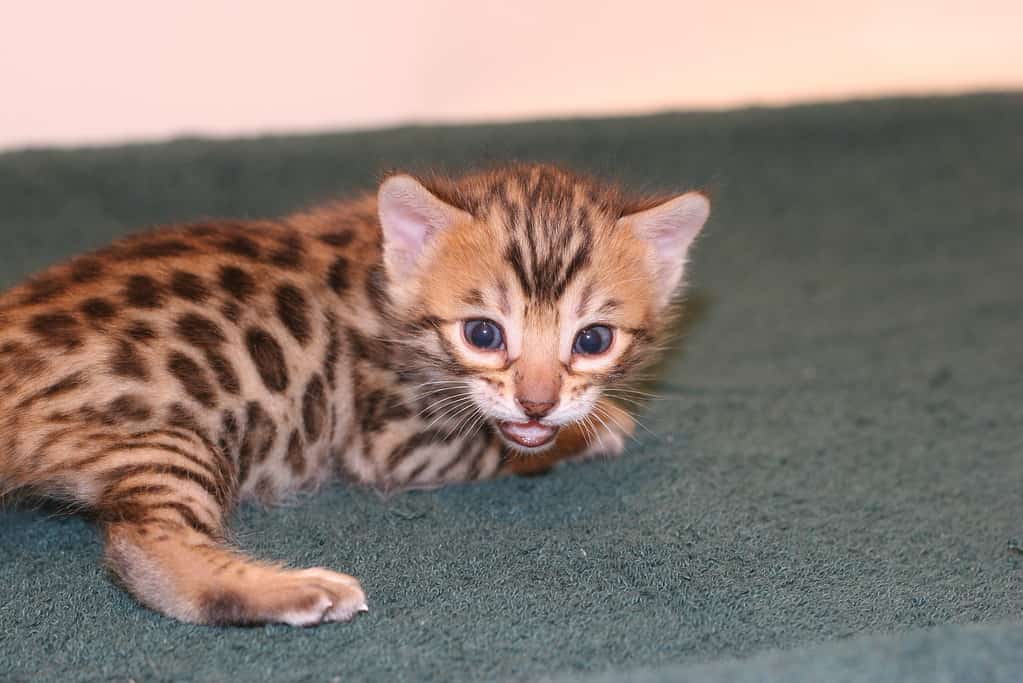
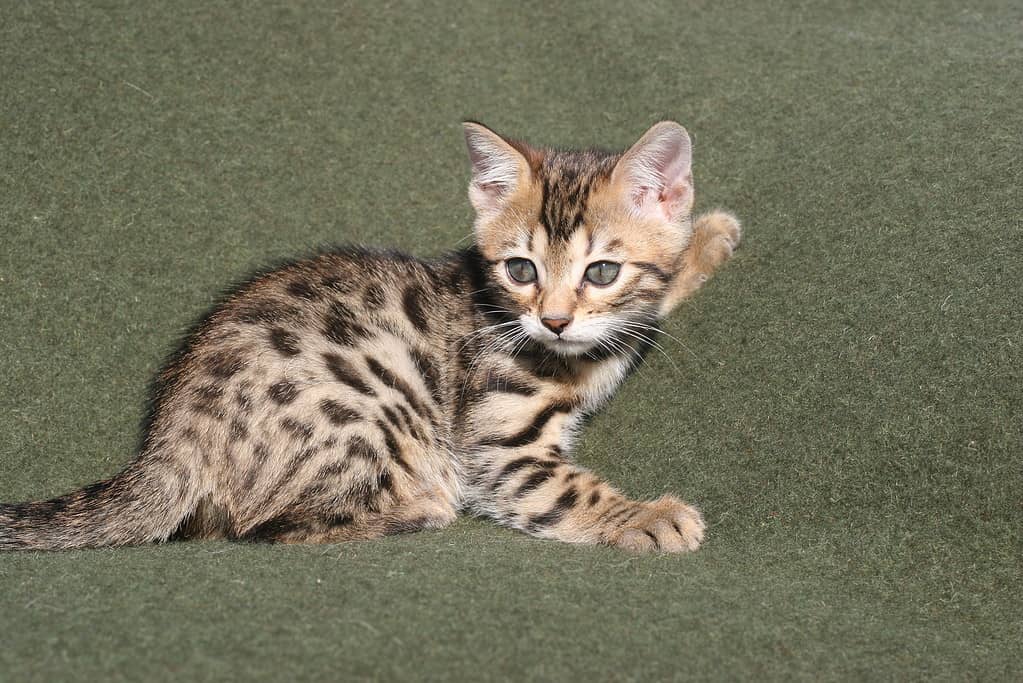
Two-month-old Bengal kittens should weigh 3-3.5 pounds and can be safely spayed/neutered.
©A-Z-Animals.com/Rachael Monson / Nemera Bengals

Between 3-4 months old, Bengal kittens reach about 4-6 pounds.
©A-Z-Animals.com/Rachael Monson / Nemera Bengals

Pictures of Bengal Kittens 7-11 Months Old
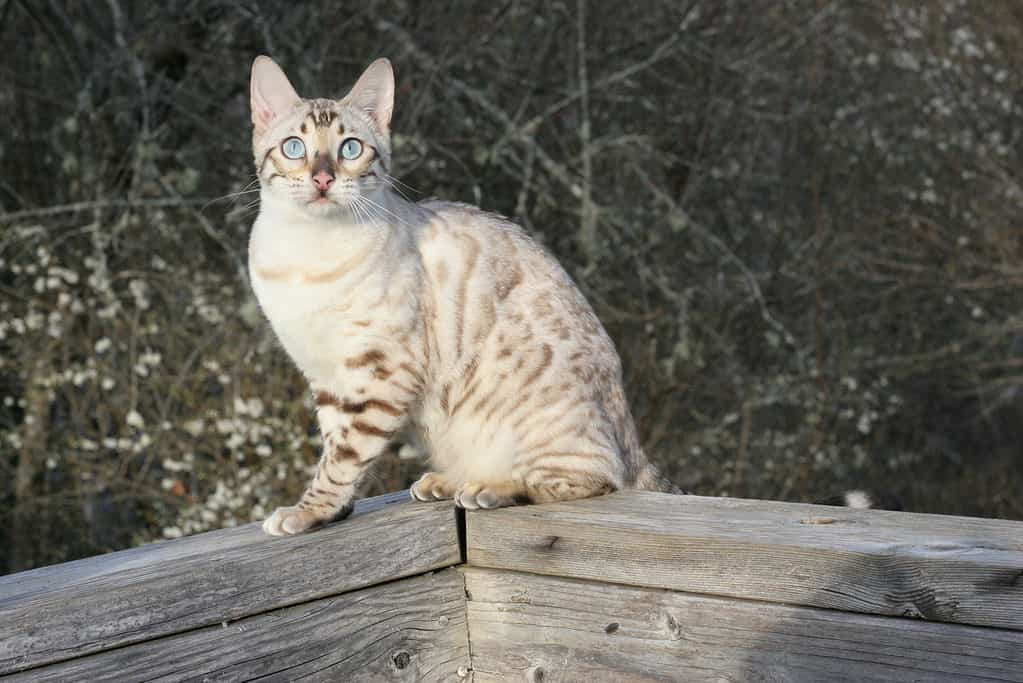
Between 7-10 months old, Bengals can weigh from 8-15 pounds!
©A-Z-Animals.com/Rachael Monson / Nemera Bengals
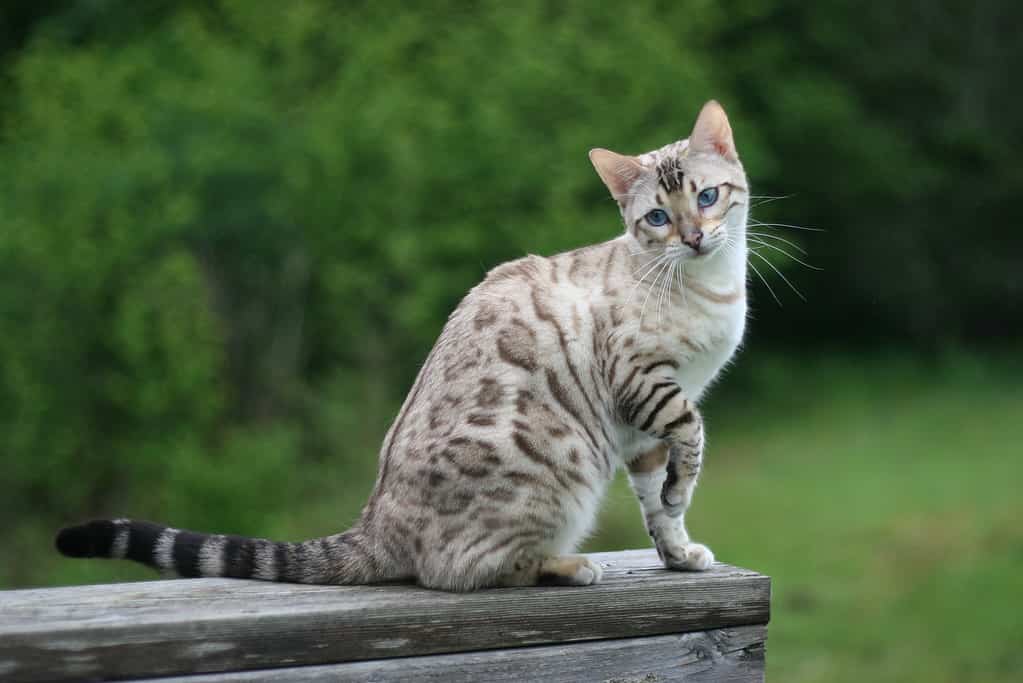
Pictures of Bengal Cat Adults
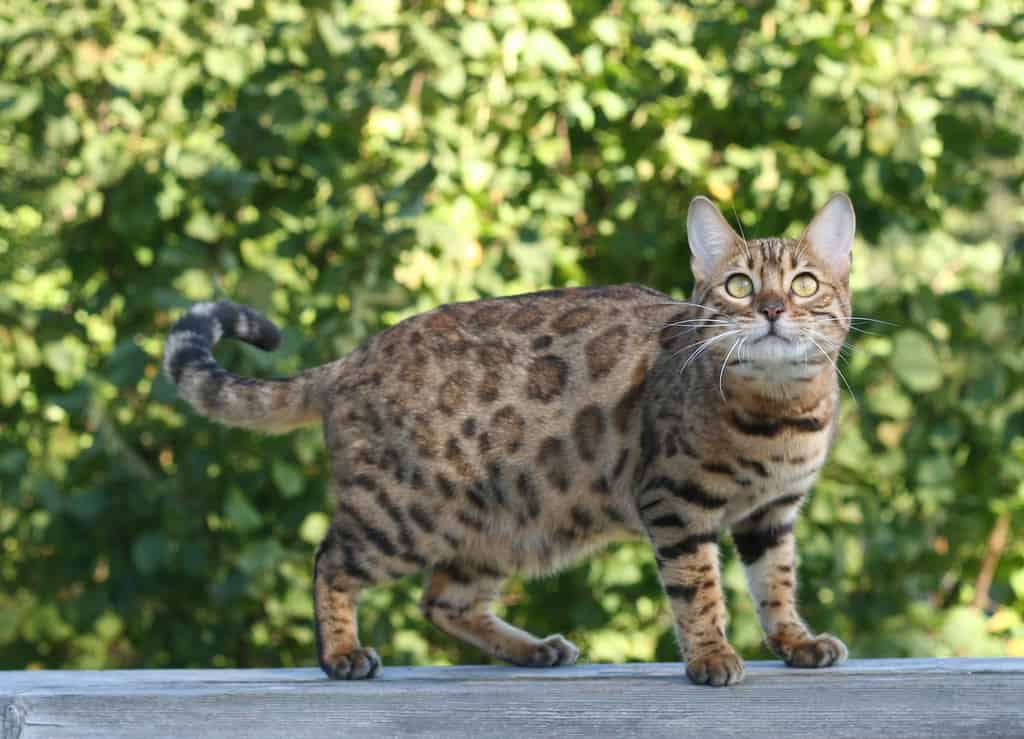

Bengal Cat Progression: Review
Bengal cats start out very small, weighing only a few ounces at birth. They grow over the next two years to weigh anywhere from 6-22 pounds. Males are generally larger than females. Bengal cats are prone to several health conditions. Selecting a good breeder and taking your cat to the veterinarian when you are worried can help them live a long, happy life. Expect your Bengal to be a part of your family for at least 12 years, and be prepared to spend a lot of time entertaining them. Bengal cats are incredible cats and wonderful pets. Is a beautiful wild-looking Bengal a cat you’d like to bring home?
The photo featured at the top of this post is ©
Thank you for reading! Have some feedback for us? Contact the AZ Animals editorial team.






